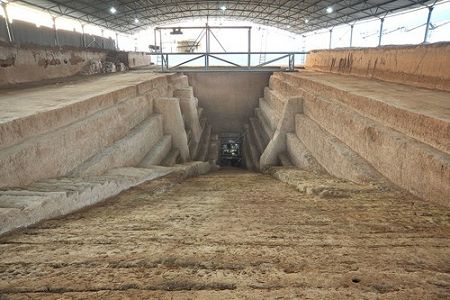Tomb of legendary general Cao Cao unearthed in Henan
|
The path leading to the front door of Cao Cao's tomb |
The tomb of Cao Cao (AD 155-220) about 2,000 years ago was unearthed in Xigaoxue village, Anyang City of central China's Henan Province, according to an announcement Dec. 27 by the Cultural Relic Bureau in Henan. Cao Cao was a famous warlord and politician who built the strong and prosperous Wei Kingdom during the Three Kingdom period (AD 208-280).
Covering an area of about 800 square meters, the tomb was found 15 meters deep under the ground. The path leading to the tomb's front door is a slope 39.5 meters long and inside the space are two chambers where three corpses, a man and two women, were found.
The man in the front chamber was found to have died in his sixties, which coincides with Cao Cao's age of 66 when he died. The two women in the back chamber were found to be at the ages of 20 and 40. According to scientific identification, the two women were probably Cao Cao's concubines, as their bone density is in good physical condition compared to other female corpses found in that period.
Although Cao Cao's tomb was raided several times before archaeologists started to excavate it in December 2008, there are more than 250 items, made of gold, silver, copper, iron, stone and jade that have so far been unearthed.
Archaeologists also found 59 engraved stone plates inscribed with the name "the king of Wei" among the articles found in the tomb. Seven of the pillows made of stone were inscribed with "often used by the king of Wei or Cao Cao" which provide the evidence to confirm the identity of the inhabitant of the tomb.
This discovering provides significant historic information in studying the Three Kingdoms period, and confirming the existence of Cao Cao's tomb, said Guan Qiang, director of the archaeology department of China's State Administration of Cultural Heritage.
 0 Comments
0 Comments








Comments